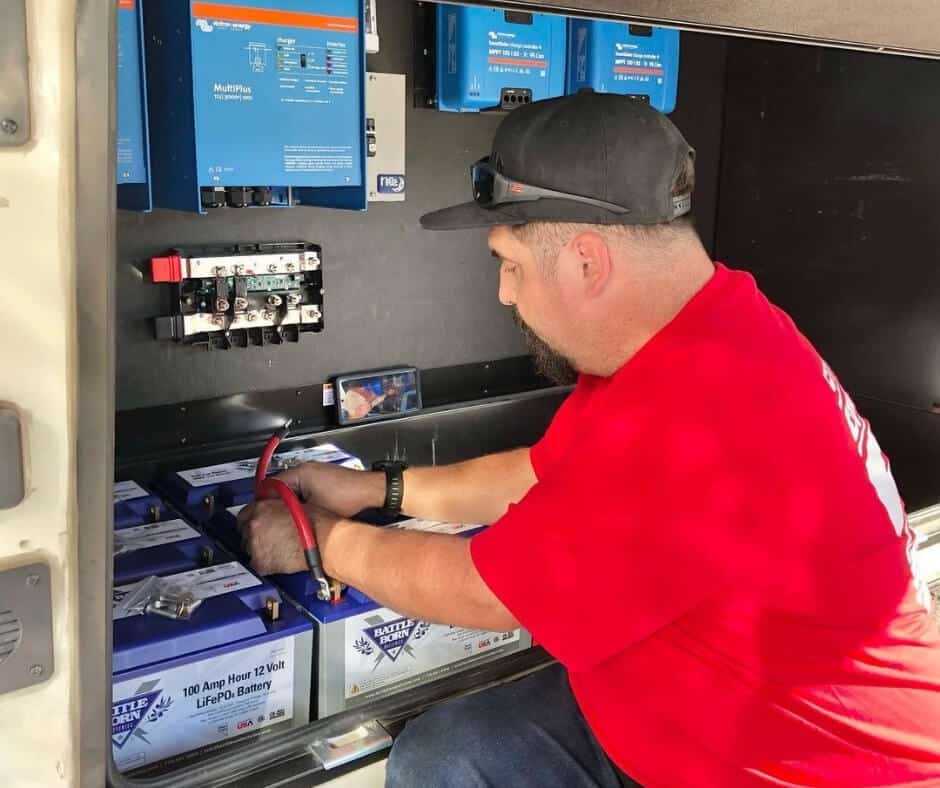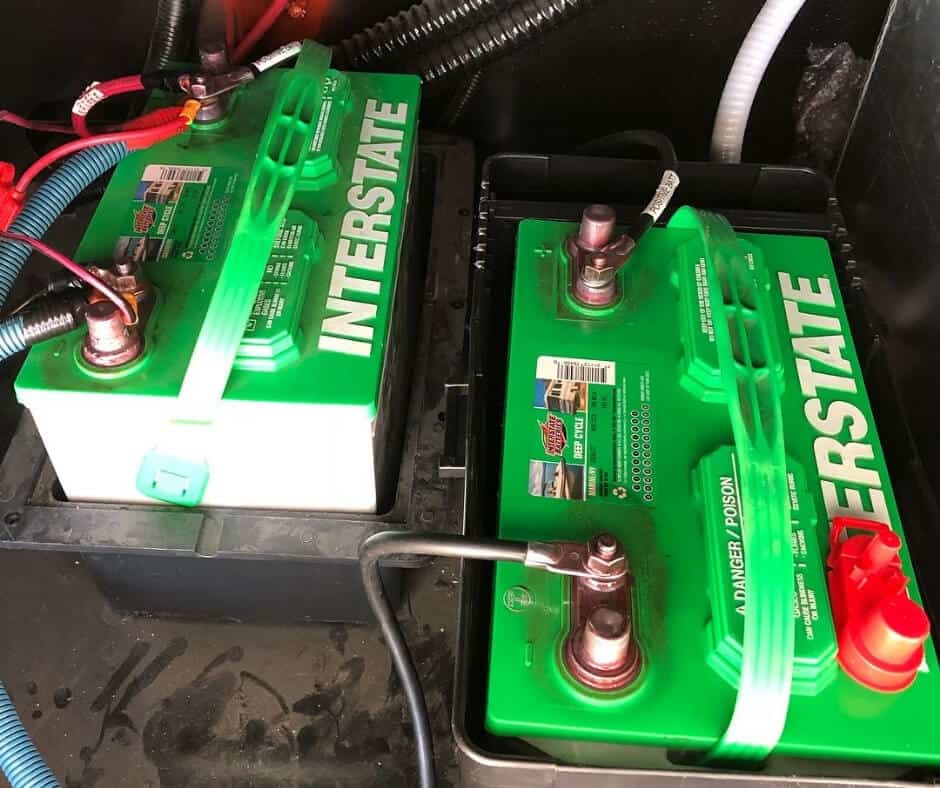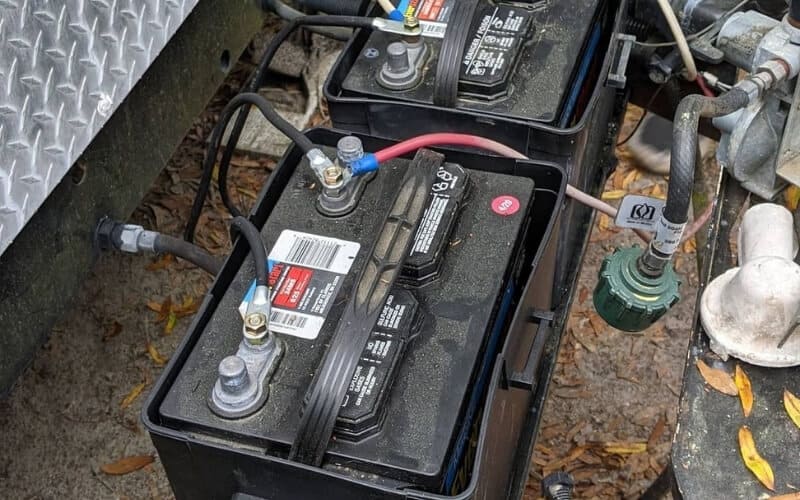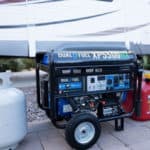There has been a lot of innovation in the realms of solar panels and RV batteries over the last decade-plus.
Lithium RV batteries are definitely one of those innovations, but are RV lithium batteries worth the cost?
For RVers that enjoy dispersed camping and boondocking, lithium batteries are a worthwhile investment. RV lithium batteries offer up to 15% higher charging efficiency (on average). They can also be charged at a much higher amperage, which means they reach a full charge much faster than a lead-acid battery.
Many of them also weigh half as much as a lead-acid battery with an equivalent energy rating.
This means you can enjoy greater energy efficiency in camp and you won’t have to lug around a super-heavy lead-acid battery when you’re moving around.
The one downfall of lithium RV batteries is their higher price tag. In some cases, they are up to five times more expensive than a comparable lead-acid battery.
That said, there are some great reasons why lithium batteries cost a bit more.
So today’s guide is going to be all about whether or not RV lithium batteries are worth the cost.
We’ll also help you understand the differences between lithium batteries and lead-acid batteries while identifying some of the myths and realities of lithium batteries for RVs.
That’s a healthy amount to cover, so let’s get started!
Are Lithium RV Batteries Worth The Money?
For reference, some of the best deep-cycle lead-acid batteries for RV cost less than $200. By contrast, the average cost of an RV lithium battery in today’s market can easily exceed $1300.
If you are looking at initial cost alone, lead-acid batteries are still the way to go.
But consider this:
The average life span of a lead-acid battery is about five years while lithium RV batteries can last up to 10 times longer.
That prompts us to do a little math.
Let’s say you stick to the lead-acid battery route and replace your battery every five years, on average.
Even if you don’t go with a high-end battery, let’s say you pay an average of $150 for every battery replacement.
Over the course of 50 years (the life cycle of one lithium battery), you will replace your lead-acid battery 10 times.
After 50 years, you will have spent $1500 on lead-acid batteries. Now, go back and look at the average price of lithium RV batteries we mentioned above.
While $200 in savings might not knock your socks off, it’s clear that, eventually, lithium RV batteries are worth the costs. But, for who?
If you are a recent retiree who is just getting into RVing and probably has 15-20 years of mobile living ahead of you, buying a few lead-acid batteries over the time span is going to be more economical than buying a lithium RV battery.
On the other hand, if you are a young professional investing in an RV for long-term use, choosing the right lithium battery for your RV may be the last RV battery you ever have to purchase.
And if you love dry camping or boondocking, lithium RV batteries are the best solution for your power needs.
They are also great for completing the ‘storage’ portion of your RV solar panel installation.

How Do Lithium Batteries Really Work?
To get a better understanding of the differences between lithium and lead-acid batteries, it’s necessary to have a basic understanding of how all batteries work.
Simply put, every battery contains two metal plates. A separator inside the battery ensures that the two metals don’t ever make contact with one another.
It still, however, allows ions and the electrolyte solution to flow freely. When you connect the two metals together by attaching the wiring harness to the positive and negative terminals, a chemical reaction occurs within the battery.
Over time, this chemical reaction will no longer produce enough power. But this internal process can be reversed by adding electrical current and, essentially, returning the chemicals to their original state.
How Are Lithium RV Batteries Different From Lead-Acid Batteries?
Now, you already know a little bit about the differences in the initial cost and lifespan of these two battery types.
Let’s highlight a few more important differences between lithium batteries and lead-acid batteries before we move on.
Internal Components
The two plates inside of every lead-acid battery are slightly different. One is made from something called sponge lead and the other is covered in lead dioxide.
Depending on the exact design of the battery, these plates are either saturated or entirely submerged in a mixture of water and sulfuric acid.
Deep-cycle lead-acid batteries are more common in RVs and they tend to have thicker internal metal plates than other lead-acid batteries.
Thicker plates allow deep-cycle batteries to discharge to a lower percentage and be recharged more frequently without sustaining internal damage.
Lithium batteries, on the other hand, work the same way as lead-acid batteries, but they contain different metals.
The most common type of lithium battery for RV use is the lithium iron phosphate battery (which you will often see advertised as ‘LiFePO4’).
In these batteries, the metal plate on the positive terminal is made of lithium-based metal oxide. The plate on the negative terminal is usually made of graphite.
They still contain a separator that keeps the metal plates from touching one another and some type of organic compound for the electrolyte solution.
Charge Time (And Efficiency)
One thing that is indisputable about lithium RV batteries is the speed and efficiency of their charging. They charge much quicker and more efficiently than lead-acid batteries.
Part of the reason for this is their ability to be charged at a higher amperage. Amps are a measurement of electrical current.
In part, they can be thought of as a measurement of electrical speed as well.
By allowing an electrical charge to be pushed into the battery at a higher amperage (electrical speed), lithium RV batteries can be charged (and recharged) much faster than their counterparts.
Discharge
As a battery discharges the electrical current stored up inside, its remaining voltage drops lower and lower.
Lead-acid batteries can really only be discharged down to about 50% of their capacity before their voltage drops too low to be useful.
Lithium batteries, on the other hand, discharge much more consistently. They also maintain a usable voltage down to about an 80% discharge threshold, on average.
This efficiency is the primary reason why the lithium RV battery lasts longer than the lead-acid battery.
Weight
Lead-acid batteries actually store a pretty low energy density when compared to lithium batteries. What this means is that lithium batteries are capable of storing more energy in a smaller space.
If you look at two batteries with equal power ratings (assuming one is a lead-acid battery and the other is a lithium battery), the lithium battery is always going to be the lighter of the two.
In addition, the materials used in the construction and manufacturing of lithium batteries are much lighter than those used in lead-acid batteries.
All of this means that lithium batteries are lighter, easier to move and take up less space than their lead-acid alternatives.

Four Major Myths About Lithium RV Batteries
When you talk to many people about lithium batteries, they may know nothing about them.
If they do, they have probably heard at least one of these two major myths about lithium RV batteries.
RV Lithium Batteries Don’t Perform Well In Cold Temperatures
In some ways, this one is well-warranted. While lithium batteries actually discharge more efficiently than lead-acid batteries in cold weather, the problem comes on the charge side.
Charging lithium RV batteries in below-freezing temperatures can lead to irreversible damage.
For many years, this is why cold weather RVers and campers have stuck to lead-acid batteries.
Fortunately, however, many manufacturers are finding ways around the cold-weather limitations of lithium batteries.
Some have installed small battery heaters that generate enough heat to sufficiently warm the battery up and allow it to be safely charged when outside temperatures are below freezing.
Other companies have built protections into their batteries that prevent them from being charged at all when temperatures dip below the programmed threshold.
While this will be extremely inconvenient when camping in cold weather, at least it will keep you from having to replace an expensive lithium battery.
In addition, you can also store your lithium battery in a heated compartment or even inside the cabin of your rig.
Many newer rigs are being designed with heated underneath storage compartments and several DIY RVers have successfully insulated their lithium batteries for four-season use.
They Are Dangerous And Unstable
This myth actually kept lithium batteries out of consumers’ hands for years. Lithium is a naturally reactive metal that even reacts when it comes in contact with something as benign as water.
Because of its reactive nature, the fear surrounding lithium batteries was that, if the electrolyte solution inside ever dried up for some reason and the two metals came in contact, the entire battery could explode or light on fire.
Thankfully, we now have millions of test cases of lithium batteries in use in RVs, truck campers, trailers, fifth wheels, and other vehicles. The reality is that very few malfunctions occur on an annual basis.
This is largely due to the fact that most responsible lithium RV battery manufacturers equip their batteries with something called a battery management system (BMS).
This system regulates charging, discharging, and a variety of other battery functions to guarantee safe operation and prevent damage to the battery.
You Must Always Keep RV Lithium Battery Recharged
With lead-acid batteries, it is generally recommended that you hold the battery at full charge as often as possible. Thankfully, this is not actually the case with lithium RV batteries.
In fact, most manufacturers will suggest that their batteries only hold a partial charge most of the time. Holding a full charge 100% of the time can actually reduce the overall lifespan of a lithium battery.
Keeping a lithium battery charged to slightly less than 100% of its capacity will increase the number of times it can be effectively cycled.
That being said, it is also a good practice to fully charge your lithium battery once in a while.
If you don’t, you can reduce the battery’s total charge capacity over time.
Thankfully, the best lithium RV batteries are equipped with those handy battery management systems that handle much of this for you.
This system is constantly monitoring the battery’s charge in order to maximize its lifespan and optimize performance.
So, the moral of the story is: don’t buy a lithium RV battery that doesn’t come with a battery management system!
RV Lithium Batteries Can’t Be Fully Discharged
While we aren’t quite sure why you would ever want to do so, some folks have also spread the myth that lithium batteries can be 100% discharged.
We already covered that lead-acid batteries become much less effective when discharged past 50% and lithium batteries are effective down to about an 80% discharge threshold.
The reality, however, is that all batteries can be fully discharged if you are really determined to do so.
With lead-acid batteries, however, it’s up to you to monitor your battery to avoid over-discharging it and causing damage.
With lithium RV batteries, their built-in BMS will often automatically stop discharge at a predetermined threshold, which is usually about 80-90 percent. This is why some folks say that these batteries can’t be fully discharged.
Either way, discharging any type of battery completely can result in irreversible damage.
The reality with lithium RV batteries is simply that most of them come with a built-in BMS that takes the pressure of battery monitoring off your plate.

The Reality Of Lithium RV Batteries
The reality of lithium RV batteries is that they are a worthwhile investment if you like to dry camp, boondocking, and and planning for long-term RV living & traveling.
Consider that the average lead-acid battery is rated for about 400 charge-discharge cycles, and that’s the high end. By comparison, many lithium RV batteries are rated for 5,000 cycles or more.
When you factor in the benefits of faster, more efficient charging, a better discharge rate, lighter weight, and the fact that they are made from more environmentally-conscious materials, there are a lot of upsides to buying a lithium RV battery.
If we are truly speaking about reality, however, you will need to be prepared to shell out upwards of $1000 for a quality lithium RV battery.
But, hey, it very well could (and should) be the last RV battery you ever need to buy!
Conclusion
Our ongoing mission is to provide articles and resources that increase your RVing Know How!
We hope that you have identified some of the pros and cons of lithium batteries and your question of are lithium RV batteries worth the cost has been answered in this guide.
If you have any additional questions about lithium batteries, or you have direct experience using one and would like to share it with our community, feel free to drop a comment below!






